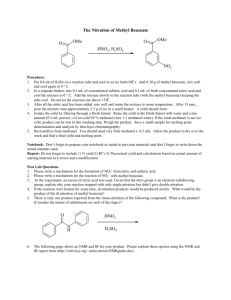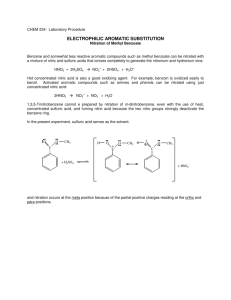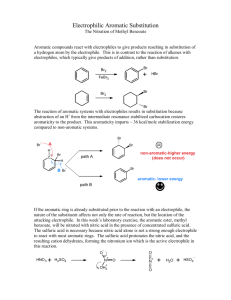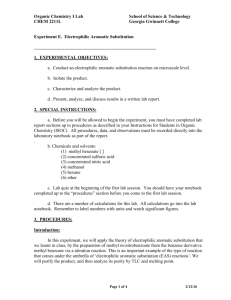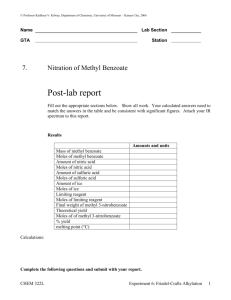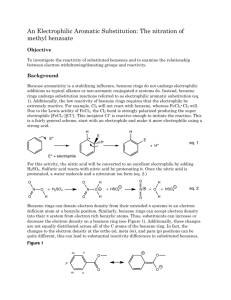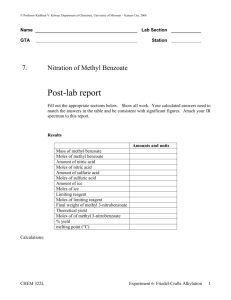Nitration of Methyl Benzoate Lab Report
advertisement
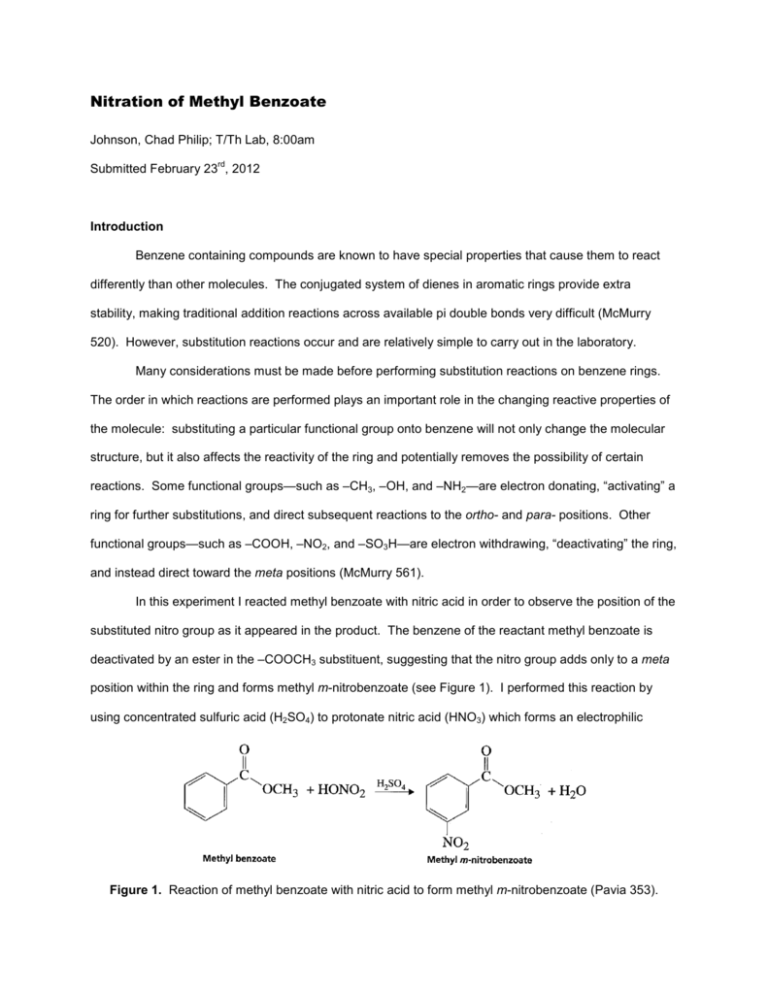
Nitration of Methyl Benzoate Johnson, Chad Philip; T/Th Lab, 8:00am rd Submitted February 23 , 2012 Introduction Benzene containing compounds are known to have special properties that cause them to react differently than other molecules. The conjugated system of dienes in aromatic rings provide extra stability, making traditional addition reactions across available pi double bonds very difficult (McMurry 520). However, substitution reactions occur and are relatively simple to carry out in the laboratory. Many considerations must be made before performing substitution reactions on benzene rings. The order in which reactions are performed plays an important role in the changing reactive properties of the molecule: substituting a particular functional group onto benzene will not only change the molecular structure, but it also affects the reactivity of the ring and potentially removes the possibility of certain reactions. Some functional groups—such as –CH3, –OH, and –NH2—are electron donating, “activating” a ring for further substitutions, and direct subsequent reactions to the ortho- and para- positions. Other functional groups—such as –COOH, –NO2, and –SO3H—are electron withdrawing, “deactivating” the ring, and instead direct toward the meta positions (McMurry 561). In this experiment I reacted methyl benzoate with nitric acid in order to observe the position of the substituted nitro group as it appeared in the product. The benzene of the reactant methyl benzoate is deactivated by an ester in the –COOCH3 substituent, suggesting that the nitro group adds only to a meta position within the ring and forms methyl m-nitrobenzoate (see Figure 1). I performed this reaction by using concentrated sulfuric acid (H2SO4) to protonate nitric acid (HNO3) which forms an electrophilic Figure 1. Reaction of methyl benzoate with nitric acid to form methyl m-nitrobenzoate (Pavia 353). + nitronium ion (NO2 ). The nitronium ion temporarily interrupts ring resonance and reacts with electrons in a pi bond to form a carbocation intermediate. This intermediate then receives electrons by the removal of + an H on the corresponding carbon atom by a base (Pavia 353). At the conclusion of the reaction both the double bond and the low energy state of the aromatic ring are restored. Experimental Procedure Reaction of methyl benzoate with nitric acid To begin the reaction I added 6mL of 18M sulfuric acid with 3.05g methyl benzoate to a 25mL Erlenmeyer flask, submerging the flask into an ice-salt bath to cool to ~0°C. Next, in a small test tube I mixed 2mL of 18M sulfuric acid with 2mL of 15.9M nitric acid and left it to cool in a separate ice bath. Using a Pasteur pipet, the sulfuric acid and nitric acid mixture was added dropwise to the sulfuric acid with methyl benzoate mixture. Because this reaction is exergonic and must be carried out at temperatures below 15°C to prevent unnecessary formation of byproduct, care was taken to ensure that the temperature did not rise too quickly. After adding all of the acid mixture I removed the flask from the ice-salt bath and allowed it to warm to room temperature. Separation of crude product The contents of the 25mL Erlenmeyer flask were then poured over ~25g of crushed ice in a 150mL beaker. After the ice had melted completely, the product was isolated by using vacuum filtration with a Büchner funnel. The contents of the funnel were washed four times with two 12mL portions of cold water followed by two 5mL portions of ice-cold methanol. After drying, 4.403g of crude product—a white clumpy solid—had been retrieved. Retrieval of methyl m-nitrobenzene To further separate the products I used a modified recrystallization technique wherein an equal mass of methanol was combined with the entirety of the crude product in a new 25mL Erlenmeyer flask. This combination resulted in a clear yellow liquid. The mixture was then brought to a calm boil on a hot plate and, after raising the temperature, only a few additional drops of methanol were added to complete dissolution. The flask was removed from the plate and left to cool to room temperature before beginning vacuum filtration, with the solid being washed this time with ice-cold methanol. Upon completion the purified product was a white solid taking the form of long, thin crystals. Test for impurities I measured the melting point and compared it to the literature value. The HNMR spectrum was analyzed by preparing a sample of product dissolved in deuterochloroform. Also, IR spectroscopy was used to make additional observations about the products by using a KBr pellet. Results Yield, melting point and appearance Table 1. Data for the reaction of methyl benzoate with nitric acid Product Methyl mnitrobenzoate † (Pavia 355) Yield (g) Yield (%) Experimental Melting Point Literature Melting Point 3.034g 74.8% 74°C – 75.5°C 78°C † Appearance White solid HNMR and IR Data Summary HNMR results are entirely consistent with the expected results. Seven total hydrogen signals appear with a group of three attached to the ester substituent (see Figure 2). IR results are also relatively -1 -1 consistent. Two signals appear for the –NO2 group at ~1351cm and ~1527cm , while the ester appears -1 -1 at ~1718cm . The meta C—H absorption reading shows up clearly at ~720cm (see Figure 3). Discussion and Conclusion The reaction occurred as expected, with the deactivated benzene directing the substitution reaction to occur at the meta position of the ring. Experimental procedures appear to have been performed successfully with an acceptable yield and a melting point temperature quite close to the literature value. Figure 2. HNMR spectrum for methyl m-nitrobenzoate Figure 3. IR spectrum for methyl m-nitrobenzoate References th McMurry, J. Organic Chemistry. 7 ed. Belmont, CA: Brookes/Cole, 2008. Pavia, D.L., Lampman, et al. Introduction to Organic Laboratory Techniques, A Small Scale Approach. 2 ed. Belmont, CA: Brookes/Cole, 2005. nd
